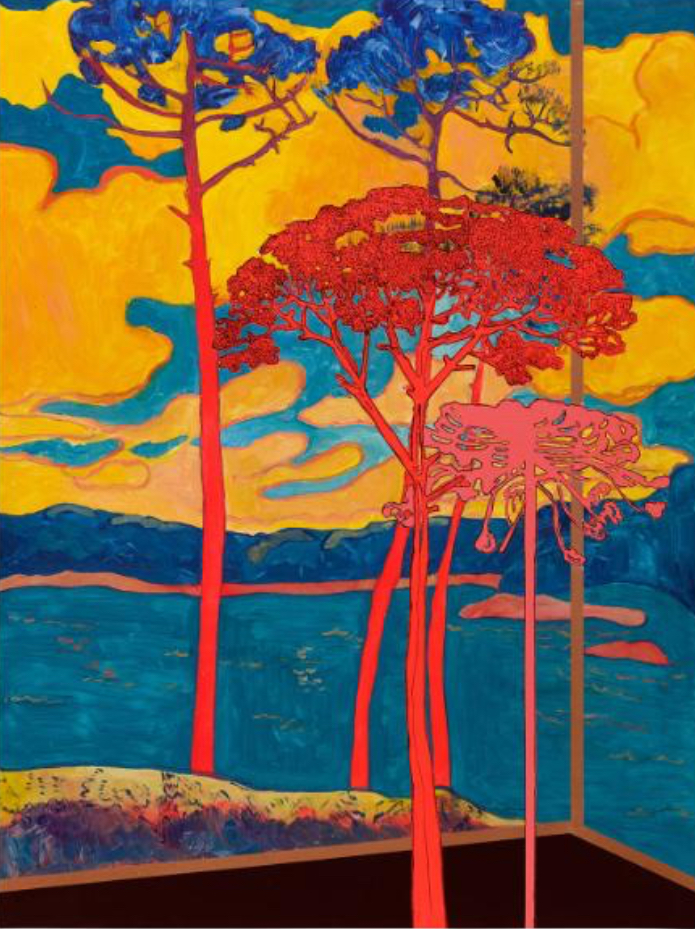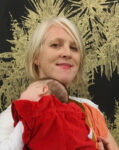
Whitney Bedford
American, 1976-
Veduta (Lacombe Red Pines), 2022
ink and oil on linen hybrid panel
36 x 27 in.
SBMA, purchase with funds provided by Kandy Budgor; Luria/Budgor family Foundation
2023.2.2

Image from Curator.site (Whitney Bedford interview) 2018
“I am… very interested in bright colors and their more sensitive shadows 9the palettes of Southern California) as the protagonists of my paintings.”
- Whitney Bedford
RESEARCH PAPER
In her artwork, “Veduta (Lacombe Red Pines), Whitney Bedford has created a dramatic and beautiful landscape. The colors are vivid and playful; the bright reds, pinks, oranges, and blues pull the viewer in. Is this an imaginary landscape or is this real?
“Veduta” recreates a famous landscape. The original artwork, “Red Pines,” was painted by Georges Lacombe in 1895. In Lacombe’s painting, only the tree trunks are red. His work shows the tree silhouettes standing out against a softly colored background of muted greens and blues.
Bedford has reimagined this scene using brilliant colors. The trees’ foliage is a deep indigo, and the tree trunks are neon red. The tree colors contrast with the vibrant orange and yellow sky. The distant blue shore is outlined in red and orange. Bedford added dazzling red and pink plants in the foreground of the picture.
Beford used the original “Red Pines” as a template for her painting and then added the daring colors and additional details. In the original painting, the two very tall pines stand in the center with the mountains, clouds, and shoreline surrounding the trees. Bedford’s artwork uses the shapes from Lacombe’s original as the starting point.
Looking closely at Bedford’s painting, the outlines of a floor and floor to ceiling windows are revealed in the foreground. Bedford painted this scene as though she was standing in the corner of a glass-walled conservatory, with beautiful plants in the interior. We look out from the protection of this structure into the brilliantly colored Lacombe scene.
Do the brilliant colors suggest that even familiar scenes may change dramatically over time? Or does the separation of the viewer and artist from the scene reflect the opaque but real barrier between man and nature?
Whitney Bedford’s “Vedute” series includes other re-imagined landscapes from artists such as Bonnard, Breton, Constable, Gauguin, and Picasso. In each painting, she infused the original images with imaginative, luminous colors. Each scene is viewed from an imaginary room in the foreground. It’s as though Beford is peering through time to look at the older masterpieces from the perspective of the present.
Veduta or the plural, vedute, is an Italian word for “view(s).” In art, veduta is a detailed, largely factual work that features a town, landscape, or other specific place. Historically, wealthy travelers completing their “grand tours” of Europe collected this art, commemorating their visits to iconic sites or cities, such as Venice.
Whitney Bedford has expanded our understanding of this genre. According to Matthew Jeffrey Abrams, “Bedford keys into this tradition, but her vedute are not so mild-mannered. They represent a pivot from veduta esatta (an exact view) to something like veduta visionaria; from views of the world to views of visions of the world.”
Bedford is not the first contemporary artist to appropriate images and give them new life. Andy Warhol famously took classic celebrity portrait photographs, added neon colors, and highlighted details for interest and excitement. The images of Marilyn Monroe, Jackie Kennedy, and James Dean became iconic thanks to the Warhol “twist.” Like Warhol, Bedford uses a playful and imaginative color palate to bring a familiar image into the contemporary art world.
Bedford is an American artist, born in 1976. She spent her early years on the east coast, in Baltimore, Maryland. She moved to California as a young adult, completing her MFA at the University of California at Los Angeles.
Whitney Bedford still lives in Southern California and is a visiting professor at several Los Angeles based universities. In addition to studying at UCLA, she was the recipient of a Fulbright award. She used the grant to study architecture for two years in Berlin.
According to Whitney Bedford’s website, “She feels that a constant sense of travel, a love of art history, a new rooted amazement at flora and fauna, and a fulcrum of a visible horizon line have most directed her work.”
Beford’s earlier works included shipwrecks, naval images, nature and beach scenes. In the Vedute series, she combines the discipline of her architectural training with a joyful imagination and daring use of color. Whitney Bedford’s works are included in the permanent collections of several major museums and galleries including the Saatchi Gallery in London and the Hammer Museum in Los Angeles.
Prepared for the Santa Barbara Museum of Art Docent Council by Carol Forhan, 2024.
BIBLIOGRAPHY
“Whitney Bedford.” Abrams, Matthew Jeffrey. “Notes on the post-pastoral landscape.” Quoted on Miles McEnery Gallery website. https://milesmcenery.viewingrooms.com/viewing-room/210-whitney-bedford/
“Whitney Bedford.” Artist’s site. https://whitneybedord.com
“Vedute/Whitney Bedford/Vielmetter Los Angeles.” L.A. Art Document, YouTube Video, February 7, 2023. https://youtu.be/pUp-KZW6_U4?si=eC31CziLcNM_ZDYE
“Whitney Bedford (Interview).” Oliver, Amanda Quinn, West Coast Editor. Curator. Archived Interviews 2016 – 2021. https://curator.site/how-they-ran-interview/2018/8/17/whitney-bedford
“Whitney Bedford.” Probst, Kate. The Women’s Studio. May 3, 2023. https://www.thewomensstudio.net/2023/03/05/whitney-bedford/
“Whitney Bedford.” Vielmetter Los Angeles. Art works and biography. https://www.vielmetter.com/artists/whitney-bedford/
